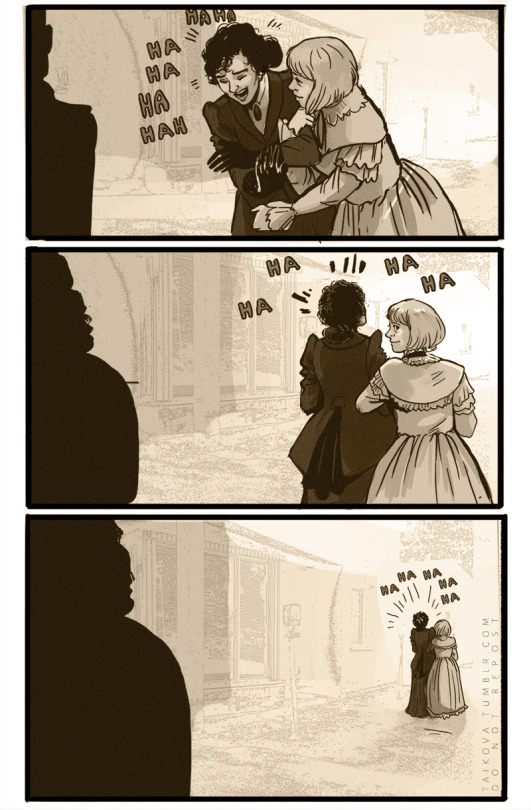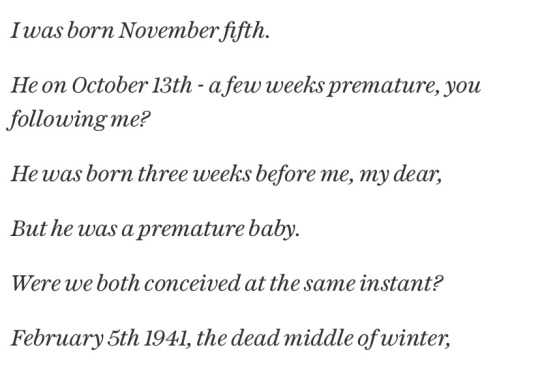el // 33 // icon by @zevraen
Last active 60 minutes ago
Don't wanna be here? Send us removal request.
Text
With severance season 2 around the corner it’s time for me to share the time I accidentally watched 4 minutes of an episode on mute and thought it was a brilliant way to show the sensory deprivation experienced by the innies
19K notes
·
View notes
Text
Thinking about how when my oldest brother took Japanese classes his professor was like your pronunciation is really good 😊 but you need to watch movies that aren't about the Yakuza because you sound like a criminal
225K notes
·
View notes
Note
i don't like soup what do you recommend
complete ego death and rebirth
31K notes
·
View notes
Note
ya dont have thanksgiving in iceland??
Have you ever had a thought
411 notes
·
View notes
Text
studying ancient history will have you thinking stuff like The 18th century was basically yesterday
5K notes
·
View notes
Text
Finding out that World Athletics pays $100k every time a new world record is set so so Mondo Duplantis has just been setting it 1cm at a time from 6.17m to 6.25m in the past 4 years is so funny??? Finessing 1 million dollars 1 cm at a time even though he can clearly go higher at one shot???? #respect
35K notes
·
View notes
Text
“Unlike Godzilla, Pacific Rim doesn’t try to be serious even when it’s being serious. Characters have names like Stacker Pentecost and Hercules Hansen. The film requires you to believe that the best way to battle a giant monster is to build an even larger robot to fight that monster. Much of the Act 2 drama derives from inter-pilot tension airlifted from the Val Kilmer scenes in Top Gun. It’s the polar opposite of the Godzilla school of drama, where everyone is a total professional who has absolutely no personal goal besides Saving The World. In Pacific Rim, Idris Elba is Rinko Kikuchi’s Obi-Wan Kenobi, and two of the last Giant Robot-pilots in the world frequently get into sneering fights over who’s the bigger badass, and Charlie Day is a scientist. So, for all these reasons, Pacific Rim is a movie that I’ve heard perfectly smart people describe as “stupid” or “silly.” The problem with this line of thinking is that, really, that every blockbuster is pretty “silly,” in the context of Things Adults Should Care About. Godzilla is not less stupid than Pacific Rim just because people frown more. […] The difference, I think, is that Pacific Rim glories in its own silliness. There’s a flashback scene where Idris Elba rescues a little girl, and when he emerges from his giant robot, the sun shines upon him like he’s the catharsis in a biblical epic. There’s a moment when one giant robot swings an oil tanker like a sword. Then it grows a sword out of its wrist. Then it falls from space to earth. There are real complaints to make about Pacific Rim, I guess, all of them fair and most of them pedantic. I know a lot of people who have issues with the story. (“Why didn’t they use the wrist-sword earlier?” is a popular one.) Conversely, I don’t really know anyone who minds the story in Godzilla, possibly because everything stupid that happens is prefaced by Frowning Watanabe saying “This is why the stupid thing that’s about to happen makes sense.” Godzilla wants so badly to make sense. Pacific Rim wants so badly for Ron Perlman to wear golden shoes.”
— Darren Franich, “Entertainment Geekly: A call for an end to serious blockbusters” (via rahleighs)
66K notes
·
View notes
Photo


victorian femlock, according to @captain-liddy’s post, which i love.
11K notes
·
View notes
Text
Happy Paul Simon and Art Garfunkel conception day guys (February 5th) (I’m not even joking)

131 notes
·
View notes
Text


the fact that we are firmly in a time where conservatives are like "the actual founding fathers, who were slaveowners, were not racist enough for my taste" is wild
42K notes
·
View notes
Text
1K notes
·
View notes
Text
“In the context of Maya mathematics, it is important to consider the Maya worldview of time, which is cyclical. All events are destined to repeat themselves, as some of our colloquial expressions indicate: “Everything that has happened, will happen again” and “Every beginning will have an end, and every end will have a new beginning.” These expressions come from our observations of nature and the cosmos. We perceive cycles in the seasons of the year, which repeat indefinitely, and in the daily motion of the Sun and other celestial objects. The Moon has four main phases: new, first quarter, full, and third quarter. The Moon is perceived as dying, to be reborn every time it passes between the Earth and the Sun. Therefore, the zero point, or Maya Nik, represents that singular instance in the cyclical motion of the Moon. The Moon does not die, but reappears, cyclically, forever. The same happens with the planets and constellations. All living things in nature go through cycles. The life cycle of a plant serves as an illustrative example. The seed, when placed underground, germinates, and with time it develops leaves, then it will produce flowers and bear fruit. The fruit will give forth the same seed as the seed that was planted, in an endless cycle. The seed is in concert with the life cycle of the plant; therefore, one of the symbols for the Maya zero is a seed. Nik, the Maya zero, is represented by several symbols: a seed, a snail, a seashell, a flower, a human head, and a headless torso[…] Another curious finding is that “today,” in the Maya worldview, is Nik, or the Maya zero. Speakers of Mayan languages know this, which becomes clear when we analyze how Mayan languages express future and past days with great ease and expanse, both into the past and towards the future. To name past and future days in my Kaqchik’el Mayan language, for example, we construct the word starting with the number of days we want to express plus a suffix implying past or future. Thus, "iwir,” or “yesterday,” in Mayan, literally means “one day into the past.” "Kabijir,” the day before yesterday, literally means 2 days into the past, and so on, indefinitely. To express future time, we say “chuwaq,” meaning “tomorrow,” meaning 1 day into the future. "Kabij," the day after tomorrow, literally means 2 days into the future, and so on, indefinitely. If yesterday and tomorrow are days with the numeral 1, then necessarily “today” is Nik, the Maya zero. It is noteworthy to point out that in Spanish or English, there are no expressions of time that go any further than two days into the past or the future; however, in Mayan languages, using the numerical construction on either side of Nik allows us to express these timeframes, past and future, ad infinitum. To express the word “today” in the Q’anjob’al Mayan language, we say “nani,” which translates to “today,” or “center.” As a matter of fact, today is at the center of the past and the future. In the K’iche’ Mayan language, “today” is expressed as “kamik,” with a literal translation meaning “death.” The philosophical connection between the word “kamik” and = Nik, is that, when a person dies, the count of the days of his or her life on Earth ends, and a new count begins from the day the person died.”
—J. Mucía Batz, “‘Nik’ — The Zero in Vigesimal Maya Mathematics”
271 notes
·
View notes



